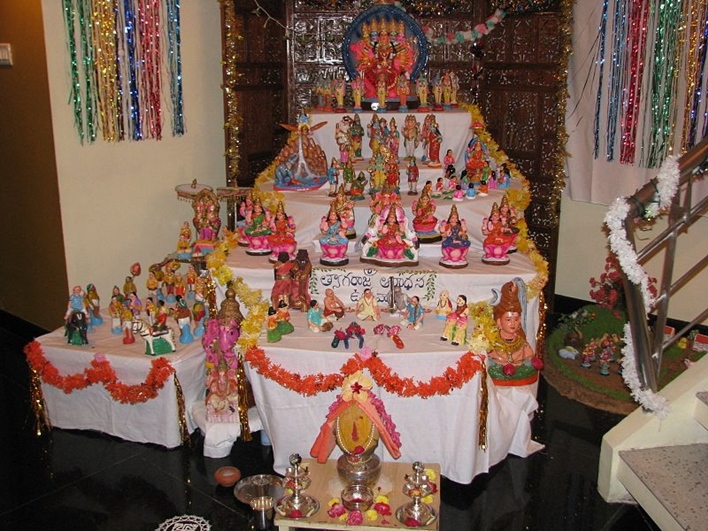Navaratri is a major festival of the Hindus that is celebrated in various styles all over the country every year. Different states of the country have different names and customs for celebrating this festival. In the southern part of India, the festival of Navaratri is celebrated with a very interesting and unique tradition called Bombe Habba or Golu or Kolu (Kannada) or Bommala Koluvu (Telugu) or Bommai Kolu (Tamil) or simply Dasara dolls. This tradition involves a toy festival that is celebrated by families across Karnataka and Andhra Pradesh.

The festival is celebrated for 10 days and culminates on the day of Vijayadashami or Dasara, the day when Goddess Durga won the battle against the demons or asuras after fighting for 9 days. In Karnataka the festival is also known as Dasara Doll Festival.
The Dasara Doll Festival of Karnataka
The Dasara doll festival is celebrated in Karnataka through an exhibition of various dolls and figurines arranged as per custom. The dolls are arranged and exhibited on a stepped platform having an odd number of steps or tiers (usually 7, 9 or 11) and usually covered with a white or light color cloth. Many households use nine steps for the exhibition of dolls to signify the nine nights of Navaratri. The dolls are ritually worshipped during the celebrations.
The main dolls of the festival are a pair depicting a husband and a wife. They are referred to as Pattada Gombe or Pattath bommaikal. This set of main dolls is handed over to a daughter by her parents during her marriage ceremony. They are presented to the new bride to start her own family and continue with the tradition of the festival.
The Pattada Gombe pair is a set of traditional dolls made from wood. These dolls are dressed colorfully using papers or silk textiles. This main pair of dolls is always dressed in the traditional style. Tradition demands that the first step of the platform be usually reserved for miniature idols or dolls depicting gods and goddesses. Generally the idols of Rama, Lakshmana, Seeta, Krishna, Radha, Shiva, Vishnu, Durga, Lakshmi, Saraswati, etc. are used in this festival. It is also customary to have a few wooden dolls in the collection.

A gollu gods and goddesses dolls decoration. Image courtesy VPradeep Banavara
Dasara Doll Steps -The Arrangement of Dolls on the Tiers
Every home selects an auspicious time to begin the doll festival. The dolls are arranged as per a specific order on the tiers or steps. The hierarchy starts from the Gods being placed at the top tiers and ends with mortals of earth placed at the lower tiers of the platform.
Steps 1 to 3: The first three steps are dedicated to figurines or idols of Gods and Goddesses. Different idols of various gods and goddesses are placed on these steps.
Steps 4 to 6: The next three steps are used to arrange dolls depicting demi-gods, great saints or kings and queens. Due importance is given to the Mysore kings during this festival and their miniature forms are generally seen placed on these steps.
Step 7: This step is devoted to showcasing of Hindu festivals, celebrations and occasions.
Step 8: This step is decorated with scenes from everyday life, such as a park, a shop, a vegetable vendor, etc.
Step 9: The last step usually depicts the evolution of mankind or living things.
There is no hard and fast rule to arrange the dolls. Every household generally increases or decreases the number of stairs according to the rows or tiers needed for displaying the various dolls available to them.
The History Associated with the Doll Doll Festival
Legend has it that Goddess Durga waged war against the demon Mahishasura. In order to help her all the Gods and Goddesses gave her all their powers. As the Gods and Goddesses became powerless, they stood as statues. Durga triumphed over Mahishasura on the 10th day of the war, which is celebrated as Dashara. To pay respect to the self-sacrifice of those dieties the doll festival is observed by worshipping the Gods and Goddesses in the form of dolls. This custom is believed to be prevalent since the existence of the Vijayanagar kingdom.

Dasara Dolls. Image courtesy GoDakshin
Customs Followed in the Doll Festival
Most households follow a theme for the arrangement of dolls. Some households follow a simple and traditional theme while some follow elaborate and extravagant ways of presenting their dolls. People use their creativity to showcase their collection in a unique and attractive manner. Some people depict stories from Ramayana and Mahabharata on the rows of the platform. These days, people also exhibit the dolls with modern themes like saving environment or reducing pollution, etc.
Every year people add a new set of dolls to their collection. As such, the collection increases every year in each household. The dolls are passed on from one generation to the next. As such, some families have dolls that are more than a 100 years old.
During the 10 days period people invite and visit friends and family and enjoy the unique exhibition of dolls in each family. Everyday an offering is presented to the dolls which are distributed among the family members, neighbors and guests as Prasad.

Dasara Doll. Image courtesy Technofreak
Significance of the Doll Festival celebration
Karnataka follows the doll festival in a way to be rooted to the traditions and introduce the new generation to the rich culture and mythology of the land. It is also a way to seek divine blessings and entertain the children during the Dasara festival.
The craft of traditional doll making is on diminishing by the day. Mysore becomes a land of dolls during the Dasara festival. The festival encourages keeping the craft of wooden and clay doll-making alive and allows the grown-ups to become children for a few days each year.
Also see,